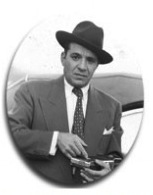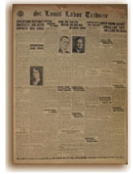Labor Tribune celebrates 82 years of publication

– Rob Grimm photo
The Labor Tribune recently marked its 78th year serving working people, and the start of our 79th year in business.
The story of the Labor Tribune began in 1935, when Maury Rubin, an architecture student at Washington University, founded a monthly broadsheet entitled the Union Labor Advocate. He changed the name of the newspaper in June 1937 to the Labor Tribune.
The Labor Tribune built its reputation by being in the forefront of national issues that affected labor. It took strong positions against the 1947 Taft-Hartley Act and the Landrum-Griffin Amendments in 1959. Locally, it exposed shoddy workmanship and promoted worker safety.
The Labor Tribune played a particularly important role in defeating the anti-worker, anti-union so called “right-to-work” legislation in Missouri in 1978, and again in 2018, with the overwhelming defeat of Proposition A (RTW).
COLORFUL START
Rubin guided the development of the paper for its first 40 years, along with a colorful staff that gave the newspaper character. Staff members included Ben Sabol, a cane-wielding photographer and who brought a ladder to his shoots, which facilitated wide-angle perspectives on group labor photographs; editorial chief Harry Winkeler, a devout anti-Communist whose red-bashing editorials were reprinted by newspapers around the country, and phone-bound ad salesmen, Morris Bass and Harry Barge.

In 1947, the Labor Tribune organized another labor newspaper in East St. Louis called the Southern Illinois Labor Tribune. The new paper was printed in the National Stockyards, the site of the Livestock Reporter. However, the Southern Illinois Labor Tribune closed its advertising and circulation office in East St. Louis after refusing to fall victim to a protection racket.
In 1984, the St. Louis and Southern Illinois Labor Tribunes merged to form the St. Louis/Southern Illinois Labor Tribune.
THE NEXT GENERATION
Rubin’s nephew, Ed Finkelstein, who first joined the newspaper for a summer job when he was 14 years old and later built his own successful career in public relations, took over management of the paper in the early 1970s, bringing in Jim Templeton as managing editor and Sherwood Kerker as a reporter.
Kerker, who was named editor of the Southern Illinois Labor Tribune in 1974 and editor of the merged St. Louis/Southern Illinois Labor Tribune in 1987, became legendary as a champion of labor’s causes, using the Labor Tribune to fight aggressively for workers and their unions.
STILL FIGHTING

Kerker retired in 1997 and was succeeded by former St. Louis Post-Dispatch reporter Dana Spitzer, whose professionalism, depth of knowledge and commitment to labor moved the paper to a new level.
Spitzer retired in 2014, and was replaced by Tim Rowden, another former Post-Dispatch reporter, who previously served as the Labor Tribune’s associate editor and senior writer.
Today, the Labor Tribune is one of the few remaining weekly labor newspapers in the country, reaching over 60,000 subscribers with 110 local unions each week.
In addition to the weekly print edition, the Labor Tribune is also available online at www.labortribune.com, and maintains an active social media presence on Facebook (facebook.com/labortribune), Twitter (@STLLaborTribune) and LinkedIn.


Leave a Reply